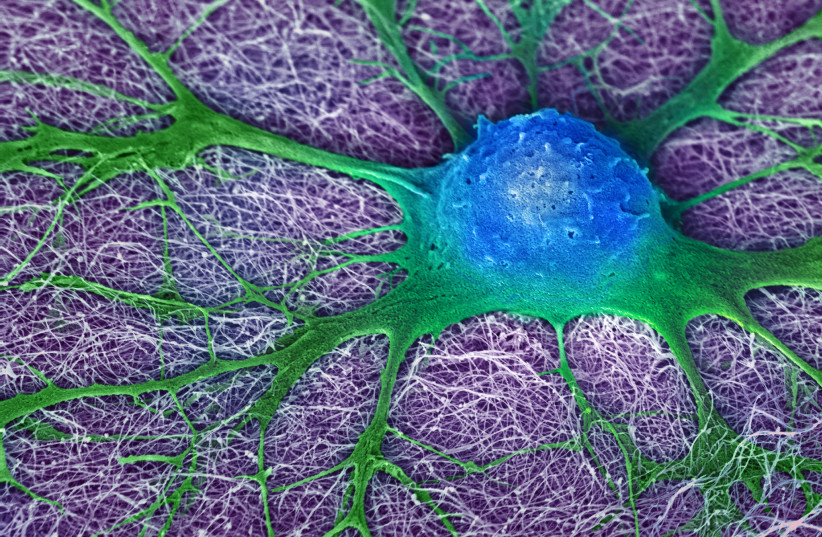Without needing human sperm to impregnate human eggs to create embryos, researchers at the Weizmann Institute of Science in Rehovot have created complete models of human embryos from stem cells cultured in the lab and managed to grow them without a womb up to the 14th day.
The team built on their recent achievement of creating synthetic stem cell–based models of mouse embryos.
The team said their breakthrough could open new avenues of research into infertility, early pregnancy failure, birth defects, drug testing and growth of tissues for transplant – as well as help scientists peer into the dramatic first weeks of embryonic development.
How to create models of human embryos
A research team headed by Prof. Jacob (Yaqub) Hanna has created complete models of human embryos from stem cells cultured in the lab – and managed to grow them outside the womb up to day 14. As just published in the prestigious journal Nature under the title “Complete human day 14 post-implantation embryo models from naïve ES cells,” the synthetic embryo models had all the structures and compartments characteristic of this stage including the placenta, yolk sac, chorionic sac and other external tissues that ensure the models’ dynamic and adequate growth.
Born in Rama, a Christian (and Druze) village in the Galilee region of Israel, Dr. Jacob (Yaqub) Hanna earned his doctoral degree in microbiology and immunology and an MD in clinical medicine from the Hebrew University of Jerusalem. He conducted postdoctoral research at the Whitehead Institute for Biomedical Research in Massachusetts and joined the Weizmann Institute in 2011. h was greatly influenced and inspired by the success of his uncle, Nabil Hanna, who invented the first antibody therapy approved by the US Food and Drug Administration in humans (Rituxan, a blockbuster anti-CD20 mAb drug for treatment of non-Hodgkin lymphoma).
He is a pioneer in induced pluripotency and reprogramming of adult cells that have regenerative properties almost identical to those of embryonic stem cells, but can be created from adult cells without using an egg or fetal material. Today, he leads an interdisciplinary group of scientists interested in understanding embryonic stem cell biology, early development and advanced human disease
Little is known about the early embryo because it’s so hard to study for both ethical and technical reasons, yet its initial stages are crucial to its future development. During these stages, the clump of cells that implants itself in the womb on the seventh day of its existence becomes, within three to four weeks, a well-structured embryo that already contains all the body organs. Given their authentic complexity, the human embryo models developed by his team could provide an unprecedented opportunity to shed new light on the embryo’s mysterious beginnings.
“The drama is in the first month, and the remaining eight months of pregnancy are mainly lots of growth,” Hanna said. “The first month is still largely a black box. Our stem cell-derived human embryo model offers an ethical and accessible way of peering into this box. It closely mimics the development of a real human embryo, particularly the emergence of its exquisitely fine architecture.”

As in that research, the scientists made no use of fertilized eggs or a womb. Rather, they started out with human cells known as pluripotent stem cells, which have the potential to differentiate into many, though not all, cell types. Some were derived from adult skin cells that had been reverted to “stemness.” Others were the progeny of human stem cell lines that had been cultured for years in the lab.
They used their method to reprogram pluripotent stem cells to turn the clock further back – to revert these cells to an even earlier phase known as the naïve state in which they were capable of becoming anything, that is, specializing into any type of cell. This stage corresponds to day #7 of the natural human embryo, around the time it implants itself in the womb. Hanna’s team had in fact been the first to start describing methods to generate human naïve stem cells, back in 2013, and they continued over the years to improve these methods that stand at the heart of the current project.
The scientists divided the cells into three groups. The cells intended to develop into the embryo were left as is. The cells in each of the other groups were treated only with chemicals, without any need for genetic modification to turn on certain genes, which was intended to cause these cells to differentiate toward one of three tissue types needed to sustain the embryo: placenta, yolk sac or the extraembryonic mesoderm membrane that ultimately creates the chorionic sac.
Soon after being mixed together under optimized, specifically developed conditions, the cells formed clumps, about one percent of which self-organized into complete embryo-like structures. “An embryo is self-driven by definition; we don’t need to tell it what to do – we must only unleash its internally encoded potential,” Hanna noted. “It’s critical to mix in the right kinds of cells at the beginning, which can only be derived from naïve stem cells that have no developmental restrictions. Once you do that, the embryo-like model itself says, ‘Go!’ ”
The stem cell–based embryo-like structures developed normally outside the womb for eight days, reaching a developmental stage equivalent to day #14 in human embryonic development that is the point at which natural embryos acquire the internal structures that enable them to proceed to the next stage: developing the progenitors of body organs.
“An embryo is not static. It must have the right cells in the right organization, and it must be able to progress – it’s about being and becoming,” Hanna added. “Our complete embryo models will help researchers address the most basic questions about what determines its proper growth.”
